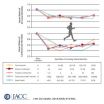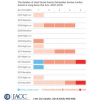(Press-News.org) Norwegian explorer Roald Amundsen reached the South Pole in 1911, but new research shows that industrial air pollution arrived long before any human.
Using data from 16 ice cores collected from widely spaced locations around the Antarctic continent, including the South Pole, a group led by Joe McConnell of the Desert Research Institute (DRI) in Reno, Nevada, created the most accurate and precise reconstruction to date of lead pollution over Earth's southernmost continent. The new record, described in an article published today in the online edition of the Nature Publishing Group's journal Scientific Reports, spans a 410-year period from 1600 to 2010.
"Our new record shows the dramatic impact of industrial activities such as smelting, mining and fossil fuel burning on even the most remote parts of the world," McConnell said.
"It is very clear that industrial lead contamination was pervasive throughout Antarctica by the late 19th century, more than two decades before the first explorers made it to the South Pole," he added. "The idea that Amundsen and Scott were traveling over snow that clearly was contaminated by lead from smelting and mining in Australia, and that lead pollution at that time was nearly as high as any time ever since, is surprising to say the least."
This study included ice cores collected as part of projects funded by the National Science Foundation. Additional ice cores were contributed to the study by international collaborators including the British Antarctic Survey, the Australian Antarctic Division and the Alfred Wegener Institute in Germany.
"The ice cores obtained through international collaborations were critical to the success of this study in that they allowed us to develop records from parts of Antarctica not often visited by U.S.-based scientists," said co-author Tom Neumann of NASA's Goddard Space Flight Center in Greenbelt, Maryland, who participated in a Norway-U.S. traverse that collected several of the cores used in this study. "This included the Law Dome region of East Antarctica and a big section of East Antarctica visited by the Norwegian-United States Scientific Traverse of East Antarctica."
All measurements of lead and other chemicals used in this study were made using DRI's continuous ice core analytical system. Low background atmospheric concentrations, together with well-known and often distinct isotopic characteristics (variants of lead with different atomic weights) of industrial sources make lead an ideal tracer of industrial pollution.
"Lead is a toxic heavy metal with strong potential to harm ecosystems," said co-author Paul Vallelonga of the University of Copenhagen. "While concentrations measured in Antarctic ice cores are very low, the records show that atmospheric concentrations and deposition rates increased approximately six-fold in the late 1880s, coincident with the start of mining at Broken Hill in southern Australia and smelting at nearby Port Pirie."
The similar timing and magnitude of changes in lead deposition across Antarctica, as well as the characteristic isotopic signature of Broken Hill lead found throughout the continent, suggest that this single emission source in southern Australia was responsible for the introduction of lead pollution into Antarctica at the end of the 19th century and remains a significant source today, the authors report.
Data from the new ice core array illustrates that Antarctic lead concentrations reached a peak in 1900 and remained high until the late 1920s, with brief declines during the Great Depression and the end of World War II. Concentrations then increased rapidly until 1975 and remained elevated until the 1990s.
Concentrations across the Antarctic continent have since declined, but still are about four-fold higher than before industrialization, despite the phase out of leaded gasoline and other mitigation efforts in many countries in the Southern Hemisphere, the report states.
"Our measurements indicate that approximately 660 tonnes [1.5 million pounds] of industrial lead have been deposited on the snow-covered surface of Antarctic during the past 130 years," McConnell said. "While recent contamination levels are lower, clearly detectable industrial contamination of the Antarctic continent persists today, so we still have a ways to go."
INFORMATION:
Lead pollution beat explorers to South Pole, persists today
2014-07-29
ELSE PRESS RELEASES FROM THIS DATE:
Generating a genome to feed the world: UA-led team sequences African rice
2014-07-29
An international team of researchers led by the University of Arizona has sequenced the complete genome of African rice.
The genetic information will enhance scientists' and agriculturalists' understanding of the growing patterns of African rice, as well as enable the development of new rice varieties that are better able to cope with increasing environmental stressors to help solve global hunger challenges.
The paper, "The genome sequence of African rice (Oryza glaberrima) and evidence for independent domestication," was published online in Nature Genetics on Sunday.
The ...
Research letter examines pacemaker use in patients with cognitive impairment
2014-07-28
Dr. Nicole R. Fowler and her fellow reserachers have found that patients with dementia were more likely to receive a pacemaker then patients without cognitive impairment.
Older adults with mild cognitive impairment (MCI) and dementia can have co-existing cardiac illnesses and that makes them eligible for therapy with devices to correct rhythm abnormalities. But the risks and benefits need to be weighed carefully with patients, families and clinicians.
The authors examined data from the National Alzheimer Coordinating Center Uniform Data Set gathered from 33 Alzheimer ...
Electronic screening tool to triage teenagers and risk of substance misuse
2014-07-28
Bottom Line: An electronic screening tool that starts with a single question to assess the frequency of substance misuse appears to be an easy way to screen teenagers who visited a physician for routine medical care.
Author: Sharon Levy, M.D., M.P.H., of Boston Children's Hospital, and colleagues.
Background: Substance use can cause illness and death in adolescents. Screening adolescents and intervening if there is substance use can reduce the burden of addiction. The American Academy of Pediatrics and other professional organizations recommend that primary care physicians ...
Dementia patients more likely to get implanted pacemakers, says Pitt study
2014-07-28
PITTSBURGH, July 28, 2014 -- People with dementia are more likely to get implanted pacemakers for heart rhythm irregularities, such as atrial fibrillation, than people who don't have cognitive difficulties, according to researchers at the University of Pittsburgh School of Medicine. In a research letter published online today in JAMA Internal Medicine, the researchers noted the finding runs counter to expectations that less aggressive interventions are the norm for patients with the incurable and disabling illness.
To look at the relationships between cognitive status ...
Non-endoscopic migraine surgery provides significant symptom relief
2014-07-28
A revised version of a surgical procedure to treat severe chronic migraine headaches led to significant symptom relief more than 90 percent of the time in patients treated at Massachusetts General Hospital (MGH). Physicians from the MGH Division of Plastic and Reconstructive Surgery report that more than half of 35 patients treated with the non-endoscopic procedure – all of whom had headaches associated with compression of craniofacial nerves – reported complete symptom relief a year later. The team's paper has received advance online publication in the journal Plastic ...
Gender disparities in cognition will not diminish
2014-07-28
The study, published in the Proceedings of the National Academy of Science, investigated the extent to which improvements in living conditions and educational opportunities over a person's life affect cognitive abilities and their implications for men and women.
"Our results show that there is no reason to expect all cognitive gender differences will diminish," says Daniela Weber, IIASA researcher and lead author of the study. "However, the findings from this study suggest that if women and men had equal levels of education, then we should expect a female advantage in ...
Running reduces risk of death regardless of duration, speed
2014-07-28
Running for only a few minutes a day or at slow speeds may significantly reduce a person's risk of death from cardiovascular disease compared to someone who does not run, according to a study published today in the Journal of the American College of Cardiology.
Exercise is well-established as way to prevent heart disease and it is component of an overall healthy life, but it is unclear whether there are health benefits below the level of 75 minutes per week of vigorous-intensity activity, such as running, recommended by the U.S. government and World Health Organization.
Researchers ...
Endurance runners more likely to die of heat stroke than heart condition
2014-07-28
Heat stroke is 10 times more likely than cardiac events to be life-threatening for runners during endurance races in warm climates, according to a study published today in the Journal of the American College of Cardiology. The authors noted the findings may play a role in the ongoing debate over pre-participation ECG screenings for preventing sudden death in athletes by offering a new perspective on the greatest health risk for runners.
Two of the most recognized causes of sudden death during an endurance race are arrhythmic death, sudden death usually caused by undetected ...
Learning the smell of fear: Mothers teach babies their own fears via odor, research finds
2014-07-28
ANN ARBOR, Mich. — Babies can learn what to fear in the first days of life just by smelling the odor of their distressed mothers, new research suggests. And not just "natural" fears: If a mother experienced something before pregnancy that made her fear something specific, her baby will quickly learn to fear it too -- through the odor she gives off when she feels fear.
In the first direct observation of this kind of fear transmission, a team of University of Michigan Medical School and New York University studied mother rats who had learned to fear the smell of peppermint ...
New study confirms water vapor as global warming amplifier
2014-07-28
MIAMI – A new study from scientists at the University of Miami Rosenstiel School of Marine and Atmospheric Science and colleagues confirms rising levels of water vapor in the upper troposphere – a key amplifier of global warming – will intensify climate change impacts over the next decades. The new study is the first to show that increased water vapor concentrations in the atmosphere are a direct result of human activities.
"The study is the first to confirm that human activities have increased water vapor in the upper troposphere," said Brian Soden, professor of atmospheric ...




